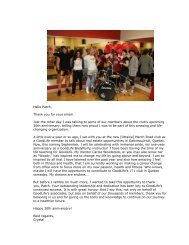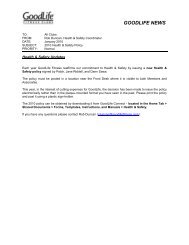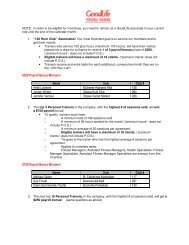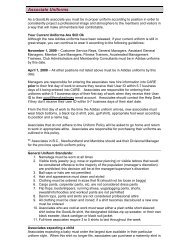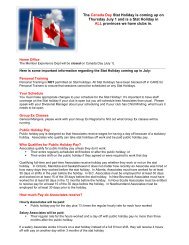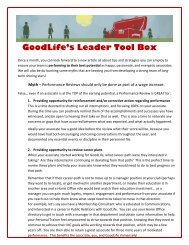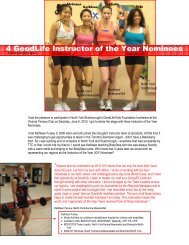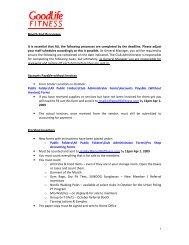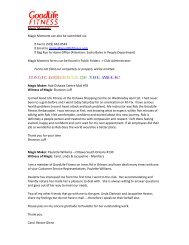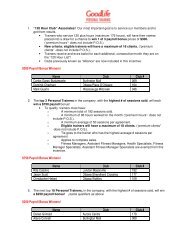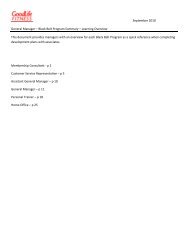Updated Policy and Procedure Handbook - GoodLife Fitness
Updated Policy and Procedure Handbook - GoodLife Fitness
Updated Policy and Procedure Handbook - GoodLife Fitness
- No tags were found...
You also want an ePaper? Increase the reach of your titles
YUMPU automatically turns print PDFs into web optimized ePapers that Google loves.
What if the baby is born later than expected? An employee who used all 17 weeks ofpregnancy leave before the baby was born would be able to remain on pregnancy leaveuntil the birth, <strong>and</strong> then, in most cases, begin her parental leave.Can an employer require an employee to provide proof she is fit to return to work?No, an employer cannot require an employee to provide written medical documentationthat she is fit to return to work.What about giving notice about ending a leave? If the employee doesn't specify areturn date, the employer may assume she will take the full 17 weeks (or any longer periodthat she may be entitled to).What about when an employee plans to take parental leave after pregnancy leave?An employee who took pregnancy leave who is planning to take parental leave must giveher employer written notice. This may be given at the same time as notice is given for thepregnancy leave, if the employee wishes, or if it isn’t; it must be given at least two weeksbefore the pregnancy leave ends.________________________________________________________________________________(EI) Employment Insurance – Maternity BenefitsMaternity benefits are employment insurance payments from the federal EmploymentInsurance program (EI). Under this program, eligible workers can receive maternity benefitpayments during their pregnancy leave. Maternity benefits are payable to the birth motheror surrogate mother for a maximum of 15 weeks. To receive maternity benefits you arerequired to have worked for 600 hours in the last 52 weeks or since your last claim. Youneed to prove your pregnancy by signing a statement declaring the expected due or actualdate of birth.The mother can start collecting maternity benefits either up to 8 weeks before she isexpected to give birth or at the week she gives birth. Maternity benefits can be collectedwithin 17 weeks of the actual or expected week of birth, whichever is later. Please notethat the date you file your claim is very important in order for you to receive the maximummaternity benefits you are entitled to.If you are unsure about your most advantageous maternity period to receive maximumbenefits, please contact the Service Canada Centre in person or at 1 800 206-7218 from8:30 am to 4:30 pm <strong>and</strong> press "0" to speak to a representative. If the actual date of birth isdifferent from the expected date of birth, it is very important that you provide this date assoon as possible after the birth of your child to determine the most advantageousmaternity period, in order to receive the maximum maternity benefits you are entitled to.If your baby is hospitalized, then the 17 week limit can be extended for every week yourchild is in the hospital up to 52 weeks following the week of the child's birth. You will stillreceive benefits for a maximum of 15 weeks, but payments can be delayed until your childcomes home. However, if you received maternity benefits prior to the birth <strong>and</strong> wanted toreceive the remaining benefits when your child comes home, call the telephoneinformation service at 1- 800-206-7218 from 8:30 am to 4:30 pm <strong>and</strong> press "0" to speak toa representative to have the necessary adjustment made to your claim.Who is eligible? To be entitled to maternity, parental or sickness benefits you must showthat: your regular weekly earnings have been decreased by more than 40%; <strong>and</strong> you haveaccumulated 600 insured hours in the last 52 weeks or since your last claim. This period iscalled the qualifying period. If you have been paid EI benefits in the past <strong>and</strong> you receiveda written notice, for example, a warning letter or a penalty letter, for making a falsestatement, the required number of hours worked to claim maternity, parental <strong>and</strong> sicknessbenefits will be higher.Qualifying period: The qualifying period is the shorter of: the 52 week-period immediatelybefore the start date of a claim, or the period since the start of a previous EI claim if thatConfidential <strong>and</strong> Proprietary Information of <strong>GoodLife</strong> <strong>Fitness</strong> Clubs | V16 October 2009 56



